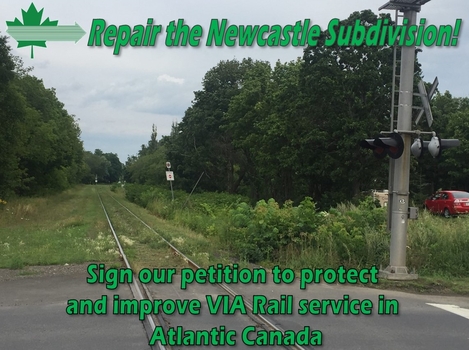
Transport Action Atlantic is encouraged by another forward step this week in the Halifax commuter rail proposal. As a long-time advocate for convenient, affordable and sustainable public transportation, TAA is excited about the various developments in public transportation planning underway in Halifax at the moment, particularly the work underway on the Integrated Mobility Plan, but believes there is still much room for improvement. In addition to measures like transit priority and bus route redesigns, commuter rail has the potential to play a major role in the transportation future of Halifax, according to the public transportation advocacy group.
“There is undoubtedly an appetite right now for the development of commuter rail in Halifax,” says TAA vice-president Ashley Morton. “This was on clear display last year, with the strong showing at public meetings and the outpouring of overwhelmingly supportive comments from the public during that time. The current system needs improvement, and many people see commuter rail as the solution to slow commutes on the western side of the Harbour, caused by over-clogged roadways from Bedford, Sackville and Fall River towards the Peninsula.”
TAA believes Halifax has a unique opportunity for commuter rail. Unlike many cities that may wish to look at such a system, it already has an underutilized rail corridor linking several major suburban communities to downtown. The rail corridor parallels a major commuter thoroughfare, the Bedford Highway, along which there has been very significant population growth in recent years, passes Halifax’s three universities, and ends deep into the southern part of the downtown core, nearly on the waterfront.
“It once had additional tracks and hosted many more freight and passenger trains every day, so there is no doubt it could do so again with relatively small infrastructure investments,” Mr. Morton noted. “As many people said during the public engagement period last year, using this corridor for a commuter rail system just makes sense.”
Though supportive in principle, TAA is urging caution with the implementation of any new system. In order to be successful, commuter rail must be planned in the context of the greater Halifax transportation network, and designed to meet the needs of users, rather than simply being a system of convenience, dictated solely by what is the easiest to do. Careful consideration must be given to scheduling, integration with buses, the location and accessibility of stations, the type of equipment used, and the way the network can work with the mobility patterns in the city.
The details will matter a great deal, and will likely be definitive, in terms of whether the system will succeed or fail:
- Bus routes must fully integrate with the service, with bus and train stops at the exact same locations, so that users don’t have long walks to connect.
- Fare collection must be integrated, with a single monthly pass or fare transfer system used for both train and bus, so that it doesn’t become a “boutique” product, or worse, a direct competitor to the bus.
- Details of loading and unloading, including platform heights, barrier-free access, and ticketing systems, are crucial to allow the train to realize the true speed benefits of not being stuck in traffic.
- Service should be co-ordinated with other Bedford-Highway-based transportation, so that citizens can depend on public transportation on that corridor all day – not just during rush hours.
“Commuter rail also presents an opportunity to shape the development of the city, and to connect communities in an efficient, effective and sustainable manner,” says Ashley Morton. “If the development of the network is rushed, or it fails to consider the many essential connections and linkages required to operate successfully, it may meet an untimely demise. For example, high-quality bus service such as bus rapid transit (BRT) on connecting routes from Spryfield, Timberlea, Fairview and Lower Sackville will multiply the positive effect of commuter rail. Without such connections, many people from those areas will still be forced to drive – probably watching the train rolling past them on the highway.
“As a regional organization, TAA’s focus is largely on inter-regional transportation, linking towns and communities outside of city centres. In the past, we have urged HRM to consider its mobility planning in terms of regional integration; it should be simple, efficient, and cost-effective to get from Halifax to Bridgewater, Kentville, Truro, Sydney and Moncton, not just Dartmouth and Bedford. The fact that this proposal has been brought forward by VIA Rail, a Crown Corporation that already provides inter-regional transportation in the Maritimes, opens up new possibilities for exactly this kind of regional integration. VIA’s investment in a commuter rail network in Halifax may help to grow and enhance their presence in the province. VIA’s plans to implement additional regional rail services between Moncton and Halifax in the near future may provide opportunities to seamlessly integrate their regional services with commuter rail, providing even more options for the travelling public. TAA would be very excited with such a development.
“We encourage the Municipality to co-operate with VIA Rail, and explore what could be an excellent opportunity to jumpstart a system that will have far-reaching benefits for the city – today, tomorrow, and far into the future. Commuter rail has the potential to play a key role in achieving many of the transportation objectives that the city has decided to pursue, and with a clear appetite from the public for exactly this kind of development, the time to act is now.”
Background:
Halifax recently received an “unsolicited proposal” from VIA Rail to potentially run a commuter rail service from Windsor Jct. to downtown Halifax, similar to what was explored in the city’s commuter rail study last year. On August 2, 2016, Halifax Regional Council voted unanimously to direct staff to enter negotiations with VIA. These discussions are expected to take several months, after which the issue will return to council, hopefully with a concrete proposal for evaluation. Optimistic projections suggest a system could be running within a year, but it remains to be seen if this is realistic.
A news report on the subject can be found HERE.






An excellent development by VIA. It is important to look at the stops that VIA operated at Armdale, Rockingham, Bedford and Windsor Junction and add one or two more stops for example at Fall River, Grand Lake, Enfield & Elmsdale.
Apparently the service VIA is proposing would mirror what was examined in the CPCS study for HRM last year. That study had a scenario running to Windsor Jct. that had stops at the VIA Station, South End (near the Universities), West End (basically the former Armdale station), Rockingham, Mill Cove, Sunnyside, Bedford Common, and Cobequid Rd. They did also look at a scenario running to Elmsdale, but that was deemed to be a less practical option. It sounds like VIA’s proposal is the shorter system, which likely makes sense as a first step.
On a separate note, if VIA moves forward with the regional (Halifax-Moncton) services they’ve been talking about, they have indicated that they may look at adding additional stops like those you mentioned.